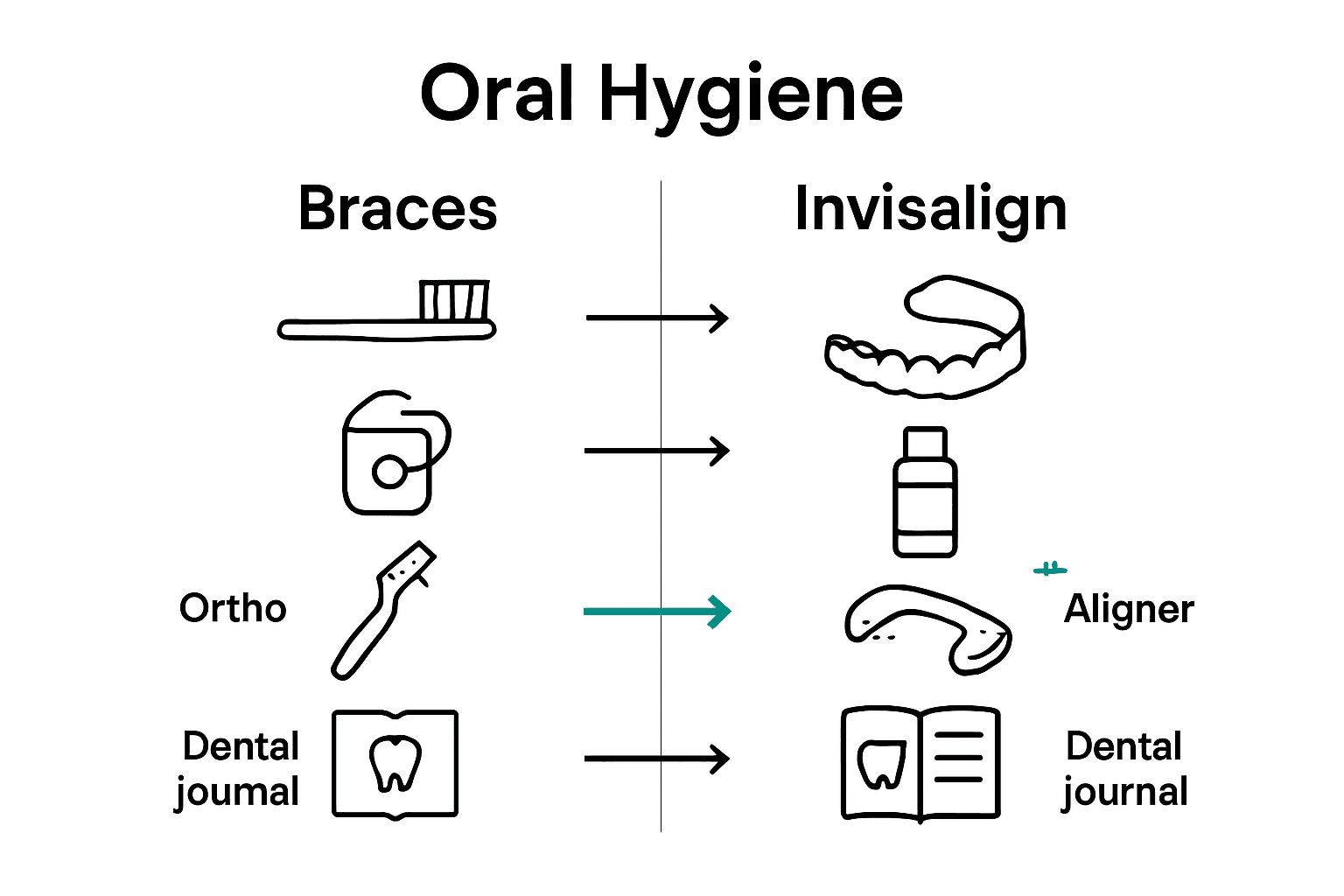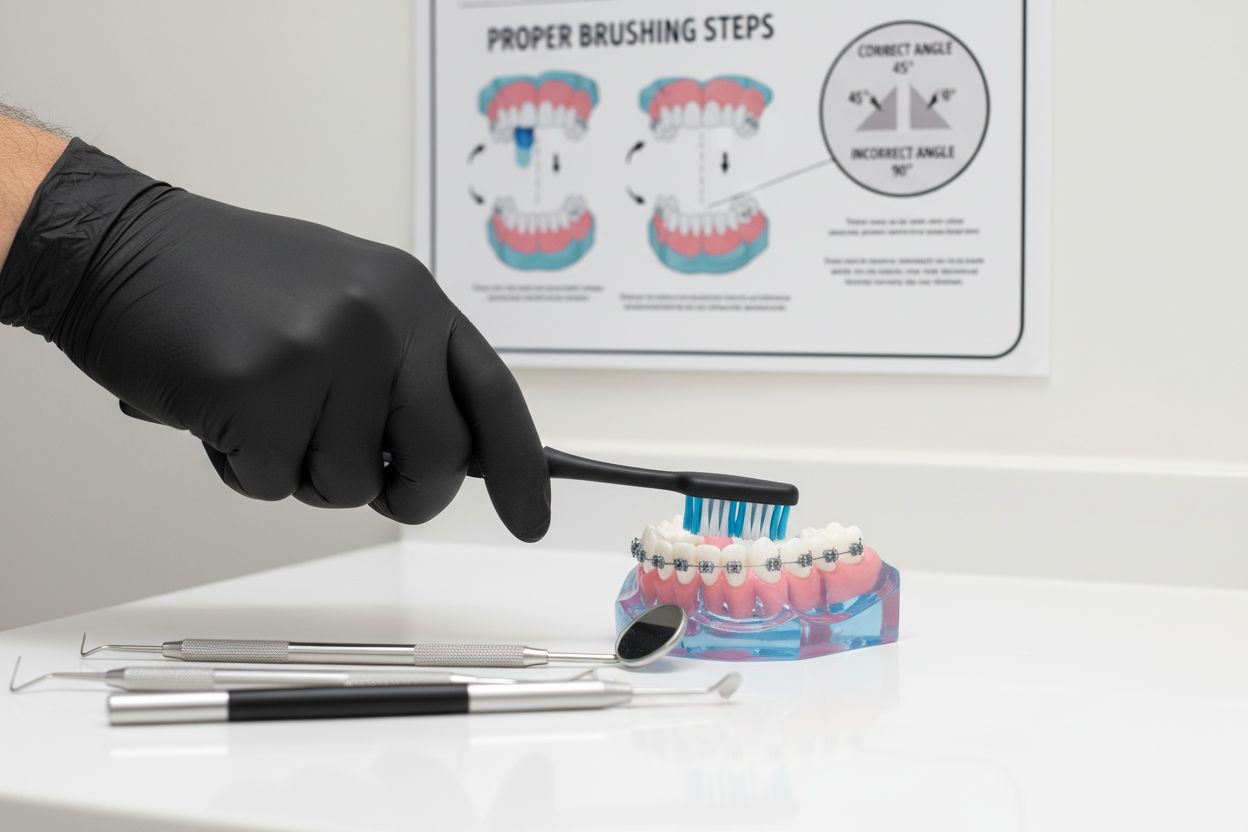How to Maintain Oral Hygiene Naturally for Braces and Invisalign
October 19, 2025
How to Maintain Oral Hygiene Naturally for Braces and Invisalign
Did you know that people with braces or aligners are up to three times more likely to develop gum problems if they overlook daily oral care? Orthodontic treatment can make every brush and floss feel like a challenge, yet good habits now can save you years of dental trouble down the line. With the right strategies and tools, keeping your teeth healthy during this journey becomes a lot easier and helps set you up for a brighter, worry-free smile.
Quick Summary
| Key Point | Explanation |
|---|---|
| 1. Use Specialized Oral Care Tools | Essential tools include soft bristled toothbrushes, interdental brushes, and fluoride toothpaste for effective cleaning with braces or Invisalign. |
| 2. Master Proper Brushing Techniques | Follow the Charter Technique to brush at a 45-degree angle, ensuring thorough cleaning around brackets and gumlines. |
| 3. Floss Daily with Proper Tools | Use floss threaders and water flossers to effectively clean between teeth and around braces or before reinserting aligners. |
| 4. Rinse with Antimicrobial Mouthwash | Use alcohol-free mouthwash to reduce bacterial growth and enhance oral hygiene, especially after meals and brushing. |
| 5. Monitor Your Oral Health Regularly | Be vigilant about changes in gum health and sensitivity, and adjust your routine as needed to avoid complications. |
Table of Contents
- Step 1: Prepare The Right Oral Care Tools
- Step 2: Implement Effective Brushing Techniques
- Step 3: Incorporate Flossing And Interdental Cleaning
- Step 4: Rinse And Use Recommended Oral Care Products
- Step 5: Monitor Oral Health And Adjust Habits
Step 1: Prepare the Right Oral Care Tools
When you’re dealing with braces or Invisalign, your oral care toolkit becomes your secret weapon for maintaining a healthy smile. Think of this step like prepping for a mission where your teeth are the target and cleanliness is the goal.
Your essential arsenal will include specialized tools designed to navigate the unique challenges of orthodontic treatment. According to research from ClearView Orthodontics, you’ll want both manual and electric toothbrushes. Electric toothbrushes can be particularly effective because they often improve plaque removal compared to traditional manual brushing.
For your comprehensive oral care kit, gather these must-have items:
Here’s a summary of essential oral care tools for braces and Invisalign:
| Tool | Braces | Invisalign |
|---|---|---|
| Soft bristled toothbrush | Yes (manual/electric) | Yes (manual/electric) |
| Ortho V-bristle toothbrush | Recommended | Optional |
| Interdental brushes | Highly recommended | Useful |
| Fluoride toothpaste | Essential | Essential |
| Dental floss/water flosser | Required | Required |
| Aligner cleaning solution | Not needed | Required |
- Soft bristled toothbrush (manual or electric)
- Orthodontic specific toothbrush with V-shaped bristles
- Interdental brushes for tight spaces
- Fluoride toothpaste
- Dental floss or water flosser
- Aligner cleaning solution (for Invisalign wearers)
Pro Tip: If you’re using Invisalign, Daily Ortho recommends rinsing your aligners before reinserting and soaking them daily in recommended cleaning solutions to maintain hygiene.
Remember that your specific needs might vary slightly depending on whether you have traditional braces or clear aligners. The key is consistency and thoroughness in your oral care routine. Your future self will thank you for the extra effort you put in now.

Ready to move on to the actual cleaning process? Let’s get those teeth sparkling clean.
Step 2: Implement Effective Brushing Techniques
Now that you have your oral care toolkit ready, it is time to master the art of brushing with braces or Invisalign. Your brushing technique can make a massive difference in maintaining dental health during orthodontic treatment.
According to Ortho Studio, the Charter Technique is the gold standard for brushing with braces. This method involves positioning your toothbrush at a precise 45‑degree angle to the gumline and using short circular or back‑and‑forth motions. The goal is thorough cleaning that reaches those tricky spots around brackets and along the gumline.
Here is your step by step brushing strategy:
- Start with your toothbrush at a 45‑degree angle to your gums
- Use gentle circular or back‑and‑forth motions
- Clean the outer surfaces of your teeth first
- Move to the inner surfaces with the same technique
- Brush the chewing surfaces thoroughly
- Pay extra attention to the areas around brackets or aligners
Pro Tip: Follow the 3‑3‑3 rule recommended by orthodontic experts. Brush three times a day, within three minutes after meals, and for three minutes each session.
If you have traditional braces, take extra care to clean around each bracket. Angle your brush to ensure you are reaching all sides of the bracket. For Invisalign wearers, remove your aligners before brushing to ensure a comprehensive clean.
Remember that patience and thoroughness are key. Rushing through your brushing routine will not give you the deep clean you need. Take your time and be meticulous.

Ready to dive into the next critical step of your oral care routine? Let us explore flossing techniques that will keep your smile healthy and bright.
Step 3: Incorporate Flossing and Interdental Cleaning
Flossing with braces or Invisalign might seem tricky, but it is your secret weapon against plaque and potential dental issues. Think of flossing as the ninja of your oral care routine reaching places your toothbrush cannot even dream of accessing.
According to Baller Dental and Orthodontics, if you have braces, you should floss once daily using specialized tools. Your arsenal for this mission includes:
- Floss threaders
- Super floss
- Proxy brushes
- Water flossers
For Invisalign wearers, Wolfe Dental recommends flossing at least once daily ideally before bed. The key steps are simple: remove your aligners before flossing and ensure thorough cleaning before reinserting.
Pro Tip: Water flossers can be game changers for both braces and Invisalign wearers. They provide a powerful yet gentle clean that traditional flossing sometimes misses.
Your technique matters more than you might think. Gently slide the floss between teeth using a careful up and down motion. For braces wearers, navigate around brackets with extra patience. If traditional floss feels challenging, consider waxed floss or floss picks which can make the process smoother.
Consistency is your best friend in this process. A few minutes of dedicated flossing can prevent weeks of potential dental complications. Your future smile will thank you for the effort you put in now.
Ready to level up your oral hygiene game? Let us explore some advanced cleaning strategies that will keep your teeth sparkling.
Step 4: Rinse and Use Recommended Oral Care Products
Your oral care routine is almost complete. The final touch involves strategic rinsing and selecting the right products to maximize your dental health during orthodontic treatment. Think of this step as the protective shield for your emerging smile.
According to UNLV Orthodontics, you have powerful weapons in your arsenal. A hydrogen peroxide antiseptic mouth rinse can be used up to four times daily to reduce gum inflammation. Sodium fluoride gel applied nightly will help strengthen your tooth enamel and prevent potential decay.
When choosing your rinse, Ortho Studio recommends an alcohol free antimicrobial or fluoride mouthwash. These rinses serve multiple purposes:
- Reach areas missed by brushing
- Reduce bacterial growth
- Freshen your breath
- Provide additional protection against cavities
Pro Tip: Swish your mouthwash thoroughly but gently. For braces wearers, angle the liquid to ensure it reaches around brackets and wires.
If you have Invisalign, remove your aligners before rinsing. Rinse both your mouth and the aligners separately to maintain optimal hygiene. When using fluoride products, avoid eating or drinking for 30 minutes after application to maximize absorption.
Consistency is key. Make rinsing a non negotiable part of your daily oral care ritual. Your future self will appreciate the extra effort you are putting in now.
Ready to learn some advanced maintenance tips that will keep your orthodontic treatment on track? Let us explore some expert strategies.
Step 5: Monitor Oral Health and Adjust Habits
Your orthodontic journey is not just about following a routine its about becoming a detective of your own dental health. Monitoring and adjusting your oral care habits can mean the difference between a smooth treatment and potential complications.
According to ClearView Orthodontics, poor oral hygiene during orthodontic treatment can lead to serious issues like tooth decay, gum inflammation, and irreversible enamel decalcification. This means your vigilance is not optional. It is essential.
What should you watch for? Pay attention to these key indicators:
- Changes in gum color or texture
- Increased sensitivity while eating or drinking
- White spots developing on teeth
- Unusual discomfort around brackets or aligners
- Bleeding during brushing or flossing
Dailey Orthodontics warns against a common mistake brushing too hard. This can actually damage your gums and wear down enamel instead of cleaning effectively.
Pro Tip: Use a pressure indicator or mirror to check your brushing technique. Your brush should feel like its dancing across your teeth not jackhammering them.
Consider keeping a weekly oral health journal. Track your cleaning routine, note any changes or concerns, and be ready to discuss them with your orthodontist. This proactive approach can help catch potential issues early.
Remember that your mouth is constantly changing during orthodontic treatment. What worked last month might need adjustment now. Stay flexible and attentive.
Ready to ensure your smile stays on the path to perfection? Keep learning and stay committed to your oral health journey.
Upgrade Your Oral Hygiene Experience With Glow Orthodontics
If you struggle to keep your braces or Invisalign clean, even after following the best brushing and flossing tips, you are not alone. Many patients find it tough to navigate daily care tools and routines that actually protect their smile through orthodontic treatment. The article outlines complex steps and special products, which can feel overwhelming without support. That is exactly why Glow Orthodontics exists. Here, you will find real solutions for every stage of your orthodontic journey, especially when it comes to maintaining natural oral hygiene.

Our team will not only recommend the right oral care tools and show you how to use them, but also offer personalized tips backed by orthodontic expertise. Curious if your habits are protecting your teeth and gums while you use braces or Invisalign? Reach out to schedule a consultation today. Take the first step toward a cleaner, healthier smile and discover why so many patients across Langley trust our warm, knowledgeable professionals. Your best results begin with the right guidance—do not wait until small issues become big problems. Visit Glow Orthodontics now and experience the difference for yourself.
Frequently Asked Questions
How do I effectively brush my teeth with braces or Invisalign?
To brush your teeth effectively with braces or Invisalign, position your toothbrush at a 45-degree angle to your gums and use gentle circular motions. Clean the outer, inner, and chewing surfaces thoroughly, paying extra attention to brackets or aligners. Brush for three minutes, three times a day, ideally after every meal.
What type of toothpaste should I use while wearing braces or Invisalign?
Use fluoride toothpaste to strengthen your teeth and protect against decay during orthodontic treatment. Apply a pea-sized amount and make sure to cover all areas extensively while brushing. Consider fluoride gel for added enamel protection, especially at night.
How often should I floss with braces or Invisalign?
Floss at least once a day, preferably before bed, to remove plaque and food particles that your toothbrush may miss. Use floss threaders or super floss to navigate around braces or brackets easily, ensuring clean spaces between each tooth. Consistent flossing can help prevent gum disease and cavities.
What mouthwash is best for maintaining oral hygiene while using braces or Invisalign?
Choose an alcohol-free antimicrobial or fluoride mouthwash to reduce bacteria and freshen breath. Swish the mouthwash gently for about 30 seconds, ensuring it reaches all areas of your mouth. Use it after brushing and flossing to provide an extra layer of protection against cavities.
How can I monitor my oral health while in orthodontic treatment?
Regularly check for changes in gum color, increased sensitivity, or white spots on your teeth, as these can indicate issues. Keep a weekly oral health journal to track your daily routine and any concerns you notice. Discuss any changes with your orthodontist during your next visit to ensure prompt attention to potential issues.
What can I do naturally to reduce plaque buildup with braces or Invisalign?
Incorporate natural mouth rinses, such as saltwater or baking soda solutions, to help reduce plaque buildup and soothe gum inflammation. Rinse your mouth with these solutions once a day, ideally after brushing, to maintain oral hygiene. Also, ensure a diet high in crunchy fruits and vegetables, which can help clean teeth naturally.